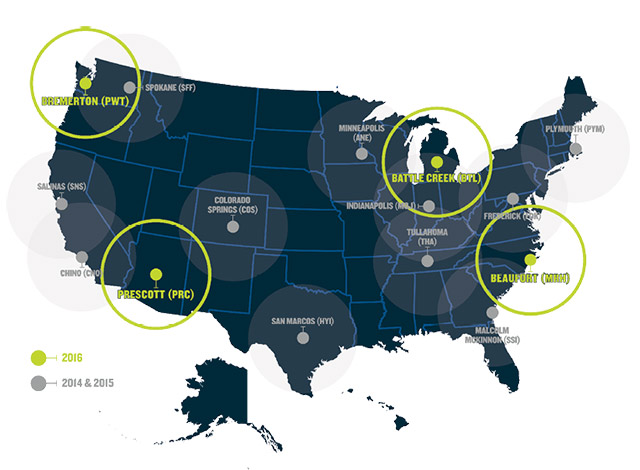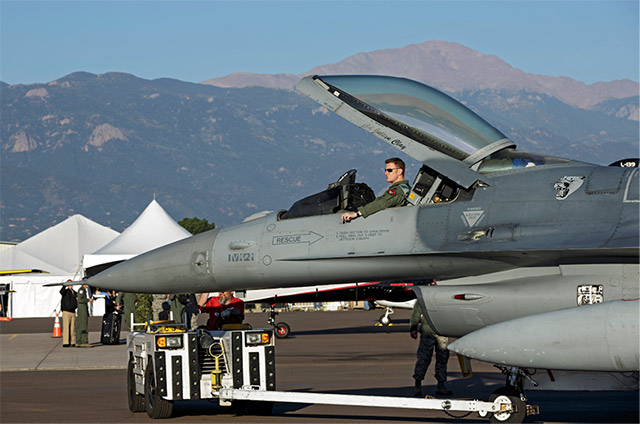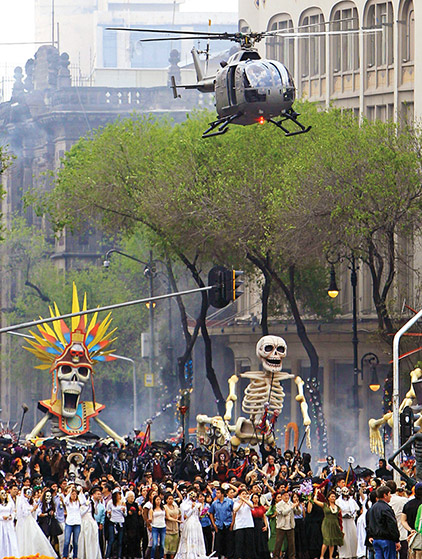 Behind the scenes
Behind the scenes
Bond, the pilot
Flying for king and country
Spoiler alert: If you haven’t seen the new James Bond movie Spectre but are wondering whether there are any aircraft scenes, we have the intel. It’s one of the most expensive Bond movies to date, and—in addition to destroying more than 10 Aston Martins for the special effects—the film shows a Britten-Norman Islander flying through an Austrian villa after a high-speed chase that includes a couple of those Aston Martins, as well as Chuck Aaron’s Red Bull helicopter disguised in military livery.
Aaron, who retired from his signature aerobatic helicopter flying in October, performs a barrel roll in the film. Bond, of course, is at the controls of the Islander. Played by Daniel Craig, James Bond always seems to know how to pilot an aircraft—no matter what situation he finds himself in, as Editor at Large Tom Horne found in doing a little research.
Gibson wins Reno
Robert “Hoot” Gibson won the Unlimited Breitling Gold Race at the Fifty-Second Annual National Championship Air Races in Reno, Nevada, September 20, unseating six-time gold winner Steve Hinton Jr. Gibson flew the P–51D Mustang Strega and covered the course in a time of 7:52:54, for a speed of 488.983 mph. Defending champion Hinton, flying Voodoo—a P–51D Mustang—did not finish the race.
Gibson, 68, of Murfreesboro, Tennessee, is a former naval aviator, test pilot, retired NASA astronaut, and professional pilot who competes regularly at the annual Reno Air Races.
“It ain’t over until it’s over,” he told the Reno Gazette-Journal. “I didn’t know I had him until I crossed the checkered flag and until I stopped on the ground and I heard them say it was a clean race.”
Second: Stewart Dawson, Celina, Texas, flying Rare Bear, a F8F–2 Bearcat; 471.957 mph. Third: Dennis Sanders, Ione, California, in Dreadnought, a Hawker Sea Fury T Mk.20; 420.361 mph.
Jet Class First: Pete Zaccagnino, Park City, Utah, in his de Havilland Vampire, Vampire; 502.370 mph. Second: Sean Cushing, Virginia Beach, Virginia, in his L–39 Albatros, Fast Company; 501.806 mph. Third: Rick Vandam, Reno, flying L–39 American Spirit at 492.234 mph.
T-6 Gold Race First: Dennis Buehn, Fallon, Nevada, flying an AT–6, Midnight Miss III; 238.073 mph. Second: Chris Rushing, Van Nuys, California, flying Baron’s Revenge; 231.808 mph. Third: Nick Macy of Tulelake, California, flying Six Cat; 231.730 mph.
Sport Class First: John Parker, Reno, in his Thunder Mustang, Blue Thunder II; 403 mph. Second: Lynn Farnsworth, Roswell, Georgia, flying the Lancair Legacy Miss Karen II; 375.483 mph. Third: Andrew Findlay, Norfolk, Virginia, in his Legacy One Moment; 356.811 mph.
Biplane Class First: Tom Aberle, Fallbrook, California, in Phantom, a modified Mong Sport; 245.109 mph. Second: Jake Steward, Lewisville, Texas, flying his Pitts S–1S Bad Mojo; 220.447 mph. Third: Jeff Rose, Carmichael, California, flying a Mong, Reno Rabbit; 200.220 mph.
Formula One Gold Race First: Steve Senegal, San Bruno, California, in Endeavor, a David Hoover AR–6; 239.432 mph. Second: Vito Wypraechtiger, Salzburg, Austria, in the Cassutt III–M Scarlet Screamer; 238.243 mph. Third: Elliot Seguin, Mojave, California, in Wasabi Siren, a Wasabi Special; 233.087 mph.
Full results from this year ’s race are online.
This month in aviation: December
December 1892. The Wright brothers open their first bicycle shop.
December 8, 1903. Samuel P. Langley’s Aerodrome, piloted by Charles Manley, crashes into the Potomac River.
December 17, 1903. The Wright Flyer lifts into the air at 10:35 a.m.; the flight lasts 12 seconds and covers 121 feet. It is the first powered, manned, heavier-than-air flight.
December 27, 1906. French emissary visits the Wrights and secures the option to buy an aircraft for $200,000.
December 10, 1911. Cal Rodgers, piloting the Wright EX Vin Fiz, completes the first transcontinental flight from Long Island, New York, to Pasadena, California.
December 24, 1925. The Wasp, Pratt & Whitney’s first engine, is completed.
December 1, 1935. First airway traffic control tower established in Newark, New Jersey.
December 17, 1935. The Douglas DC–3 takes off for the first time in Santa Monica, California.
December 1, 1941. The Civil Air Patrol is established.
December 7, 1941. Japanese attack Pearl Harbor, Hawaii.
December 20, 1957. First flight of the Boeing 707.
December 15-16, 1965. Gemini V1–A orbital rendezvous flown by astronauts Wally Schirra and Tom Stafford.
December 21-27, 1968. Apollo 8 orbits the moon (Frank Borman, James Lovell, William Anders).
December 7-19, 1972. Apollo 17 crew makes last lunar landing (Eugene Cernan, Ronald Evans, Harrison Schmitt).
December 23, 1986. Voyager flies nonstop around the world without refueling.
December 17, 2003. 100th anniversary of powered flight and first powered flight of SpaceShipOne.
December 15, 2009. First flight of the Boeing 787 Dreamliner.
December 23, 2014. Airbus delivers the first A350.
Sponsored by Breitling
 Red Bull Air Races
Red Bull Air Races
The fast and furious
Heart-stopping entertainment in Las Vegas
By Julie Summers Walker
The final Red Bull Air Race of 2015 was the second on U.S. soil and the American race pilots—Michael Goulian and Kirby Chambliss—might not have made it to the podium, but they provided heart-stopping entertainment nonetheless.
Goulian—who seemed to be an underdog in the Training Master Class (the 14 Master pilots fly the race course in trials on the first day of the two-day race)—ended up as the “fastest loser,” which might sound like a bad thing but is actually a good thing. Racers vie for the fastest time on the course in two laps of 3.7 miles each, horizontally through three air gates (82-foot-high pylons), and straight and level through the Chicane—a series of single pylons positioned in a line. They race head to head based on their times, which meant that Goulian’s losing time in his head-to-head with Austria’s Hannes Arch was the fastest of those who lost their heat. In the round of 8, Goulian was pitted against Japan’s Yoshihide Muroya.
Goulian and Muroya clocked im-pressive times, but this race comes down to one-thousandths of a second. It was Australian Matt Hall in first, Great Britain’s Paul Bonhomme second, and Germany’s Matthias Dolderer third.
Disappointment
His face said it all—and the commentator watching Kirby Chambliss’ reaction via the onboard Garmin VIRB called it his “ugly face”—the races were over for number 10 in the first round. Chambliss has raced in every season of the Red Bull Air Race since its inception in 2003.
Highly competitive, Chambliss appeared to be the U.S. favorite this year in the training rounds. The addition of winglets to his Edge 540 V3 added speed and he was fifth in the training round. But it was not to be. Head to head against Czech racer Martin Sonka, Chambliss was slightly slower than the decorated former Czech air force pilot. Disappointingly, the day of the race was his birthday.
Championship
Red Bull Air races are cumulative; points earned throughout the race season qualify the pilot to win the World Championship. Bonhomme—with his second place finish—won the 2015 championship, his third. He breaks the three-way tie of two championships with Americans Mike Mangold and Chambliss.
In a poignant end to the 2015 season, Hungarian pilot Peter Besenyei—known as “The Godfather”—announced his retirement. Two days later, so did Bonhomme. Dates and locations for 2016 will be announced in March.
Email j[email protected]
Image: Las Vegas winner Matt Hall.
230 mph
The Red Bull Air Race is the fastest motorsport series in the world.
Las Vegas race results
1 Matt Hall, Australia
2 Paul Bonhomme, Great Britain
3 Matthias Dolderer, Germany
4 Yoshihide Muroya, Japan
5 Hannes Arch, Austria
6 Michael Goulian, USA
7 Nicolas Ivanoff, France
8 Martin Sonka, Czech Republic
9 Juan Velarde, Spain
10 Nigel Lamb, Great Britain
11 Pete McLeod, Canada
12 Kirby Chambliss, USA
13 Peter Besenyei, Hungary
14 Francois Le Vot, France
Video: See the pilots battle gusty conditions and continue rivalries in Las Vegas.
TFR avoidance solutions
ForeFlight, Garmin team through AOPA efforts
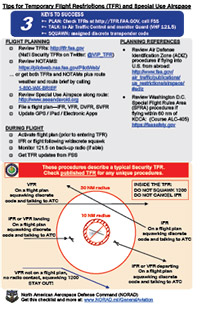 Flight planning app providers ForeFlight and Garmin are making AOPA’s TFR avoidance and intercept procedures available as downloads. ForeFlight has made available for download the NORAD TFR avoidance and intercept procedures card. The one-page kneeboard card tells pilots how to check for TFRs during preflight planning, directs them to other planning resources, and presents the intercept procedures used by NORAD and the FAA—including how an intercepted pilot is expected to respond. ForeFlight also released an update notifying subscribers that the information is now available. Garmin informed AOPA that it would include the information in a future release of its Garmin Pilot software.
Flight planning app providers ForeFlight and Garmin are making AOPA’s TFR avoidance and intercept procedures available as downloads. ForeFlight has made available for download the NORAD TFR avoidance and intercept procedures card. The one-page kneeboard card tells pilots how to check for TFRs during preflight planning, directs them to other planning resources, and presents the intercept procedures used by NORAD and the FAA—including how an intercepted pilot is expected to respond. ForeFlight also released an update notifying subscribers that the information is now available. Garmin informed AOPA that it would include the information in a future release of its Garmin Pilot software.
“No GA pilot deliberately flies through a TFR, but it still happens about 500 times per year. Through making information available and having everyone—NORAD, AOPA, and flight planning providers—work together, we believe it will help decrease the frequency of TFR violations,” said George Perry, senior vice president of the AOPA Air Safety Institute.
AOPA provides several tools to help, including a TFR Email alert system and flight planning tools. “Having ForeFlight and Garmin make information more readily available to pilots is a good thing,” Perry said. “The world has changed for GA since 9/11. As pilots we have to do our part to keep the skies safe.”
“Enhancing the ability for pilots to access TFR and safety data should increase the likelihood that a bad situation can be avoided,” said AOPA President Mark Baker. “It’s great when AOPA’s safety and government affairs divisions are able to work so closely with the military and commercial vendors to find common-sense, simple solutions that improve safety.”
Headlines that affect you
Recent news from the aviation world
AOPA convenes first high school symposium
AOPA invited school administrators, guidance counselors, and aviation program directors to its first AOPA Aviation Leadership Alliance. —AOPA Online
Drone action urged
House committee voices concerns over drone usage; looking for “balance.” —AOPA Online
ATC staffing at lowest point
The number of certified professional controllers is at its lowest point in 27 years, warns NATCA. —AIN Online
Used aircraft sales rebound
Used aircraft sales are up and business-jet aftermarket sales are expected to grow 3 percent annually from 2016 to 2025. —Aviation Week
Magazine names new editor
Stephen Pope has been named the new editor of Flying magazine, replacing Robert Goyer. —Flying magazine
Drones to be registered
Task force will work on particulars
By Jim Moore
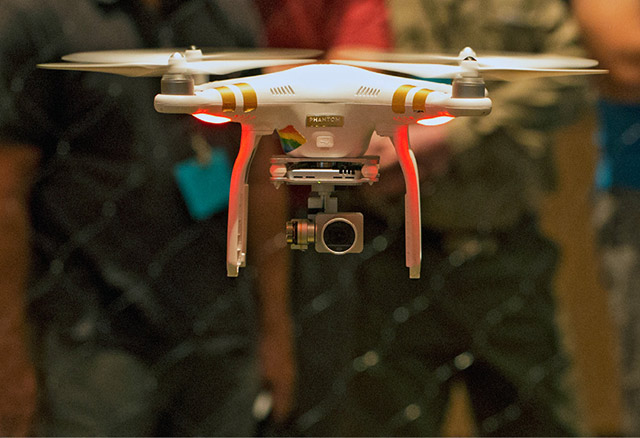
A task force of government and industry stakeholders will be assembled to work out the details of a new requirement to register all unmanned aircraft systems (commonly known as drones) at the time of sale.
U.S. Secretary of Transportation Anthony Foxx, and representatives of various groups concerned with commercial and recreational use of unmanned aircraft, announced the urgent effort to ensure that every drone is linked to a user. Commercial operators are already required to register unmanned aircraft, and federal officials said they can expand that requirement to all drones based on their existing authority and regulations.
The task force, Foxx said, “will work on a tight timeline to get this done” by November 20, with the registration requirement to be in place by mid-December. By some estimates, 1 million drones or more may be sold this holiday season. Foxx expects the registration requirement will be retroactive to drones sold prior to December, although that is still to be decided.
“There’s still a lot of work to do,” Foxx added, noting that the FAA continues to work on a final rule that will govern operation of commercial drones that weigh less than 55 pounds. The new registration requirement, meanwhile, will augment various operator education efforts, including some created voluntarily by manufacturers. The requirement to register all drones will allow the FAA and law enforcement to trace drones that violate laws or regulations back to their owner, and Foxx said the inability to do so has been a significant obstacle to enforcement of current regulations and rules.
Foxx said the task force will determine which drones will be subject to the requirement, as well as the particulars of setting up a system to gather information from buyers. The work of that task force will not interfere with or delay the FAA effort to finalize the proposed rule that will update FAA regulations governing small UAS operations. (AOPA was among more than 4,500 individuals and groups that submitted comments on that proposed rule.) Foxx said the rule remains on track to be finalized in June 2016.
AOPA will welcome an invitation to join the registration task force and work with government and industry to craft specifics of the registration requirement for small UAS, having long advocated for safe, responsible integration of unmanned aircraft. The association has joined various government and industry efforts to educate operators, and to develop regulations and policies that facilitate the safe use of airspace. AOPA will ensure the views and concerns of GA pilots are known to all involved.
Email [email protected]
SPA headed for water
The Seaplane Pilots Association will move from its landlocked Lakeland, Florida, headquarters to a more float-friendly Winter Haven facility after funds are raised to support the move.
The Winter Haven City Council will provide a 30-year lease to the Seaplane Pilots Association to develop three acres of Winter Haven Gilbert Airport’s Lake Hartridge for a public seaplane base with floating docks, picnic tables, and ramps.
“We’re going to give that right back to them for a park after we develop it,” said Steve McCaughey, SPA executive director.
The SPA headquarters building will be erected on two acres across from the lakefront base with hard-packed surfaces and pilot-operated fences and gates for access to the ramps and docks. The headquarters facility will include a 10,000-square-foot hangar, offices, and interactive workshops and educational displays.
McCaughey said the area was a natural fit because the community has demonstrated an affinity toward seaplanes. “There’s a lot of synergy and there are 40 lakes within the city’s boundaries, most of which are open to seaplanes on a regular basis. It’s a real seaplane-friendly community.” —David Tulis
2016 fly-ins announced
AOPA covering the country
After two successful seasons of hosting regional fly-ins—close to 30,000 people have attended—AOPA will keep the momentum going by hosting four events in 2016. Here are the locations and dates:
Beaufort, North Carolina. May 21, 2016. Michael J. Smith Field (MRH).
Bremerton, Washington. August 20, 2016. Bremerton National Airport (PWT).
Battle Creek, Michigan. September 17, 2016. W.K. Kellogg Airport (BTL).
Prescott, Arizona. October 1, 2016. Ernest A. Love Field (PRC).
The fly-ins are free and offer on-airport camping as well as seminars, exhibits, and displays. Many will feature aircraft demonstrations and a Friday night Barnstormers Party. Pancake breakfasts and on-site lunch options are also a part of each event. There will not be a regional fly-in at AOPA headquarters in 2016; it is anticipated that will be an every-other-year event.
Web: www.aopa.org/fly-ins
Surpassing expectations
COS and THA end on a high note
By Julie Summers Walker
Before the Colorado Springs, Colorado (COS), AOPA Fly-In in September, AOPA was projecting that by the end of the season its regional events would see more than 27,000 attendees—a number no one in the association had anticipated. With the 2015 fly-in season concluded and great crowds at both COS and Tullahoma Regional/William Northern Field (THA) in October, close to 30,000 people have attended an AOPA Fly-In since the events started.
“We didn’t expect this,” AOPA President Mark Baker told the crowds at both Colorado Springs and Tullahoma. But although attendee projections might not have been this high, projections for a great event were. “Who had fun?” he asked audiences each time at his day’s-end Pilot Town Hall. In every crowd, all hands were raised.
In Colorado, more than 2,121 attendees enjoyed perfect weather, warm temperatures, and the happy camaraderie of aviation enthusiasts. AOPA Airport Support Network volunteer Stephen Ducoff said, “We worked very hard” to get AOPA to host a fly-in there. “We think we have a fabulous airport.”
Nearly 300 aircraft flew into COS for the event, which featured a display of close to 40 airplanes and some 60 exhibitors enticing visitors. Colorado Springs is home to the North American Aerospace Defense Command (NORAD); Navy Adm. William Gortney, commander of NORAD, was a featured speaker. An F–16 delighted attendees with a midafternoon fly-by.
Tullahoma may not have had the same bright blue skies, but nonetheless more than 2,500 people attended the event. Rain couldn’t dampen the spirits of attendees at a rocking Barnstormers Party, which featured a band comprising some of Nashville’s finest musicians. By Saturday, the field was a little swampy, but the crowds came out—and so did the sun. By 10 a.m. the skies hummed with arriving aircraft. More than 330 aircraft flew in.
Tullahoma is the home of the Beechcraft Heritage Museum, which played host to the event. Full to the brim with Southern hospitality, and even with some rainy weather thrown in, Tullahoma was a happy—if a little soggy—end to the 2015 fly-in season.
Email [email protected]
When it comes to fast cars, fast women, and iconic airplanes, who’s your man? Only one: Bond. James Bond. The Bond franchise is replete with scads of aircraft, some odd, some stylish, some ridiculous. Here’s a short list of notable aircraft appearing in the films.
In Goldfinger, the villain’s fleet includes a Lockheed JetStar—flown single-pilot by Pussy Galore. Can you believe it—Galore flew the JetStar from Switzerland to Kentucky, nonstop. Impossible, with those four early turbojet engines! And too bad Goldfinger’s bad aim shot out a cabin window and sucked him into oblivion in an enduring—and false—demonstration of the power of sudden depressurization. “Where’s Goldfinger?” Galore asks Bond (Sean Connery) after Goldfinger’s window exit. “Playing his golden harp,” Bond deadpans.
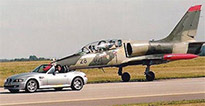
Tomorrow Never Dies Aero Vodochody L–39 Albatros.

Thunderball Avro Vulcan B.2.
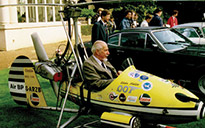
You Only Live Twice The Little Nellie WA–116 autogyro with its creator and pilot, Ken Wallis.

Octopussy BD–5J Jet.
Goldfinger also features Pussy Galore’s Flying Circus, a fleet of five Piper Cherokee 140s fitted out with poison gas. The 140s were flown by men, incidentally. They wore wigs for the in-flight scenes.
Octopussy was memorable for the opening scene in which Bond (Roger Moore) pilots a single-seat BD–5J jet, evades a missile attack by flying it through an open hangar, runs out of fuel, and lands on a highway. Where did Bond learn to fly it? It was stunt pilot Corkey Fornof at the controls.
Bond specializes in missile evasion, it seems. Tomorrow Never Dies starts with Bond (Pierce Brosnan)—apparently with another type rating under his belt—dodging rockets as he flies an Aero Vodochody L–39 Albatros.
Another movie, another demonstration of stellar pilot skill: Bond’s (Roger Moore) qualifications were apparently good enough for him to fly the Space Shuttle, the polar opposite of a BD–5J, in Moonraker.
In Thunderball, Bond (Sean Connery) straps on a Bell Aerosystems rocket belt to get away from the bad guys. Thunderball is also noteworthy for featuring a Cold War classic: the delta-winged Avro Vulcan B.2. The Vulcan, with two nuclear bombs aboard, is stolen by bad guy Emilio Largo, ditched in the Bahamas, and used for extortion. Of course, Bond locates the Vulcan and prevails in an underwater knife and spear-gun fight.
And in You Only Live Twice, Bond (Sean Connery) commands a wicked autogyro fitted out with flamethrowers, machine guns, and missiles. Of course, he shoots down four of the pursuing enemy helicopters, hampered by flying more conventional designs.
The latest film, Spectre, opened in theaters November 6.—Thomas A. Horne
Email [email protected]
Images courtesy Metro-Goldwyn-Mayer Pictures/Columbia Pictures/EON Productions
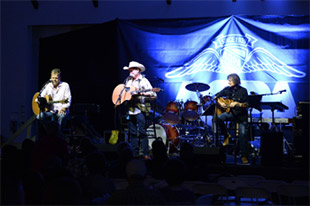
By the numbers (COS)
2,121 Attendees
305 Aircraft
63 Exhibitors
1,353 Lunches
40 Display aircraft
791 Breakfasts served
650 Barnstormers Party
26 Campers
122 Rusty Pilots
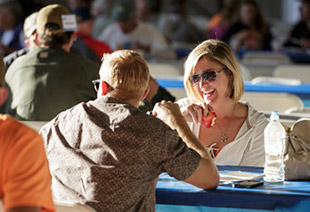
By the numbers (THA)
2,519 Attendees
331 Aircraft
56 Exhibitors
1,367 Lunches
42 Display aircraft
617 Breakfasts served
660 Barnstormers Party
54 Campers
119 Rusty Pilots
